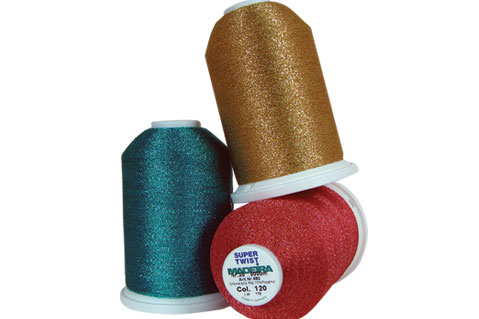Strategy February 10, 2016
How to Embroider with Metallic Thread
Don’t be daunted by tricky metallic thread. Instead, add value to your designs by mastering the art of some well-placed sparkle.

Shiny, sparkly, eye-catching and effervescent, metallic thread evokes quality – royalty even. It can set you and your customer apart from the crowd, and its higher perceived value allows you to charge a premium for your work – around 20% higher than traditional embroidery. But metallic thread can also be a challenge, requiring a bit of TLC for proper sewing. Rest assured, however: All you need to succeed are a few simple operational checkpoints once you venture beyond a 40- or 50-weight smooth, metallic thread.
Needle: If you’re unsure, go by the needle size recommended by your thread manufacturer. Each will have a suggestion to make their metallic threads run best. Some of the thinner metallics, like a 40- or 50-weight, won’t even require a needle change. Such threads consist of a metallic foil wrapped around a core of polyester, rayon or nylon. They’re smooth to the touch, but will add shine to your embroidery and will run well with a standard 75/11 needle.
Once you get into thicker metallics, you’ll need to change your needle to accommodate the thickness. A smooth 30-weight metallic thread will require a 90/14 needle, and a 20-weight thread a 100/16 needle. The larger eyes in these needles will also simplify threading your machine. Plus, a large-eye needle will cut down on friction as the metallic thread moves through the needle.
There’s another type of metallic thread, also a metallic foil wrapped around a core, but this time the foil is twisted as it’s wrapped, creating facets and producing more of a sparkle. A 30-weight of this type requires a 90/14 needle for best performance.
Design: Metallic thread doesn’t have to dominate a design to add value and interest. Using it as an accent – substituting gold for yellow or silver for gray – may be all you need. And an overlay of the sparkly twisted metallic can suggest glass, snow or jewels. It’s easy to be creative with this specialty thread. The twisted and heavier-weight metallic will do best when you incorporate them into the longer stitches of your design.
Density: Depending on the digitizing, it’s possible you can substitute a 50- or 40-weight metallic for a regular 40-weight embroidery thread with no change to the design. With the twisted metallic thread, and heavier-weight smooth metallic, you’ll use lighter densities, longer stitches and less underlay. If using the thinner 50-weight metallic, you’ll be able to accomplish shorter stitches, and may alter your density 5% up or down, depending on the substrate on which you’re embroidering.
Tension: Lighten up on the top tension of your machine to reduce stress to the metallic thread. Some embroiderers will use a thread stand placed next to the machine in order to lengthen the metallic thread’s path from cone to machine, straightening and relaxing along the way. Others use a plastic mesh cover placed over the metallic spool or cone to achieve the same effect.
Machine speed: It’s a good idea to slow down your machine for metallics. Though many high-performance commercial machines will run 1,000 to 1,200 stitches per minute for regular 40-weight rayon or polyester thread, try cutting that to around 650 to 700 stitches per minute when starting out with metallic thread.
Though they look delicate, metallic threads are often tougher than you think, with many able to hold up to high temperature wash water. Some can even withstand laundering with bleach. The thread pops up on all sorts of apparel, from caps to aprons to jeans. From youth to corporate, Irish step dancing to Western bling, metallic threads work seamlessly in just about any demographic, adding shimmer in all the right places.
